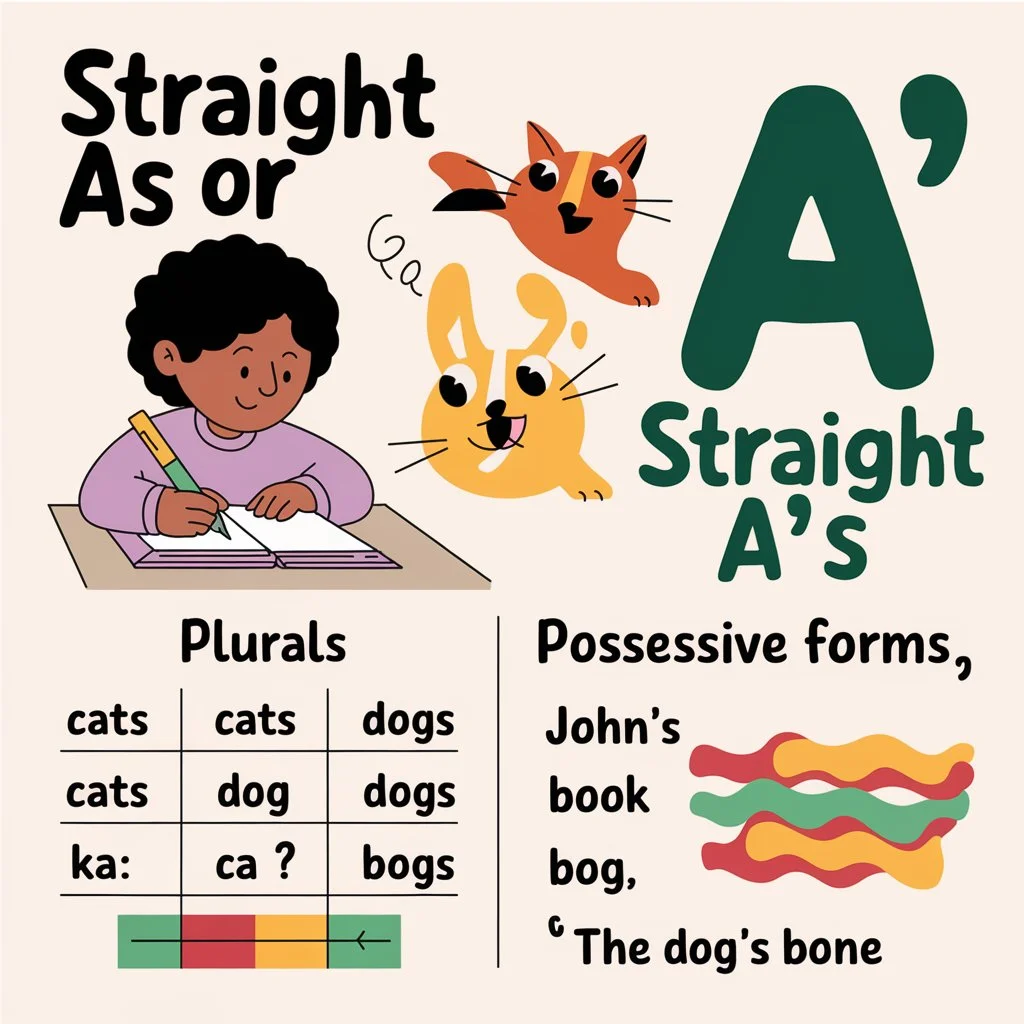Achieve academic excellence by learning whether to use Straight As or Straight A’s when referring to top grades and avoid common writing mistakes.Plurals and possessive forms follow specific rules that are essential to mastering the English language. Typically, an apostrophe is used to indicate possession, while adding an “s” forms plurals (in most cases).
In the English language, understanding the difference between plurals and possessive forms is essential. Typically, we use an apostrophe to indicate possession, and an “s” to show plurality. However, when dealing with letters or grades, the rules change slightly. Pluralizing letters like A, B, or C often requires an apostrophe to prevent confusion. This small distinction helps make written communication clearer and avoids potential misunderstandings.
Is It “Straight As” or “Straight A’s”?
The correct plural form of the grade A is “A’s.” When pluralizing a single letter, we must use an apostrophe. Although apostrophes are commonly used to indicate possession, in this case, they help to avoid ambiguity. Without the apostrophe, “As” would look like the word “as,” which could confuse readers. By writing “A’s,” we clearly show that we are referring to the plural form of the grade A.
Examples of “Straight A’s”:
- She worked hard to achieve straight A’s this semester.
- His parents were proud when he brought home straight A’s.
- You need straight A’s if you want to be valedictorian.
- Getting straight A’s requires dedication and discipline.
- She has maintained straight A’s since her freshman year.
- Colleges often look for students with straight A’s.
- He needed straight A’s to qualify for the scholarship.
- Achieving straight A’s helped her secure a spot at her dream university.
- The teacher praised him for earning straight A’s in all subjects.
- Students who get straight A’s are often considered for honors programs.
Incorrect Examples of “Straight As” (to demonstrate common confusion):
- She aimed for straight As, but it wasn’t clear what that meant.
- His goal was to get straight As in all subjects.
- The school recognized students with straight As.
- You need to work hard to earn straight As.
- He managed to get straight As despite the challenging curriculum.
- Her report card was full of straight As.
- The scholarship required applicants to have straight As.
- They both had straight As, making them top of their class.
- Achieving straight As isn’t easy, but it’s possible with effort.
- To be valedictorian, you usually need straight As.
In these incorrect examples, “Straight As” could be confused with the word “as,” making it unclear that the writer is referring to grades. Always use “Straight A’s” for clarity.
Do Grades Need an Apostrophe in AP Style?
The AP Stylebook provides detailed guidance on the use of apostrophes. In general, apostrophes are used to indicate possession, as in “the dog’s house” or “the kid’s toy.” However, when it comes to grades, the apostrophe is not used to indicate possession. Instead, we use it for clarity when pluralizing letters.
Grades, especially single letters, are one of the exceptions to the usual AP Style rules. While apostrophes are not needed to form plurals in most cases, we use them with single letters to avoid confusion. For example, without the apostrophe, “As” would be mistaken for the word “as.” Some style guides, including AP style, suggest this rule applies mainly to lowercase letters, but it’s still recommended for uppercase letters when the plural form could be easily confused with an existing word.
Examples
- A’s” in all subjects show consistent academic excellence.
- She received straight B’s in her final exams.
- To qualify for honors, you need at least three A’s and two B’s.
- His report card had C’s and D’s, which concerned his teachers.
- Colleges often prefer applicants with straight A’s in high school.
Does This Rule Apply When Pluralizing Letters in General?
Yes, the same rule applies to all letters, not just grades. For example, when pluralizing the letter B, it is clearer to write “B’s” instead of “Bs.” While you can technically write “Bs,” it’s less common and could cause confusion. Since many readers and dictionaries don’t recognize “Bs” as a word, using the apostrophe in “B’s” is the safer option.
So, whenever you need to pluralize a letter, always include the apostrophe. It’s one of the few exceptions to the typical apostrophe rules, which usually only apply to possessive forms.
9 Examples of How to Use the Plural of Grades in a Sentence
To make things clearer, here are some examples of how to use the plural of grades in sentences. Since grades are one of the most common situations where you’ll need to pluralize letters, these examples focus on that context. You’ll rarely need to pluralize letters outside of this scenario, so these should cover most situations.
- I got straight A’s on all my tests.
- She got straight B’s, apparently.
- He needs straight A’s if he wants to get into his dream college.
- You got straight D’s and haven’t made it through.
- We can’t hire someone who got straight D’s, I’m afraid.
- Your straight A’s alone are more than enough to get you in here.
- You have four A’s and three B’s, correct?
- How many B’s and C’s do I need to pass officially?
- This position needs three B’s and two C’s to apply successfully.
Tip to Remember the Plural of Grades
Here’s a useful tip to help you remember how to pluralize grades: It’s the opposite of the usual apostrophe rule. Normally, we don’t use apostrophes for plurals and only add them for possession. However, with letters, we use apostrophes to indicate plural forms.
If this rule seems tricky, try writing the letters with and without an apostrophe. In many cases, you’ll immediately see why the apostrophe is important for clarity. For example, “As” is already a word, so we need to write “A’s” to make the plural form clear. Similarly, “Us” is a word, so we use “U’s.” Even when a letter doesn’t form a common word, like “X”, writing “Xs” without the apostrophe could confuse readers. That’s why it’s clearer to write “X’s” to show the plural form.
FAQs
Why do we use an apostrophe to pluralize letters?
We use an apostrophe to pluralize letters because it helps avoid confusion between the plural form and existing words. For example, “As” could be mistaken for the word “as,” so we write “A’s” to clarify we mean the plural of the letter. Without the apostrophe, many letters can blend into existing words, making it harder to understand the writer’s intent. Therefore, the apostrophe adds clarity and readability to writing, especially with single letters. This is a unique rule that doesn’t apply to most other nouns.
What is the correct plural form of grade “A”?
The correct plural form of the grade “A” is “A’s.” Unlike most plural nouns, which simply add an “s,” grades and single letters follow a different rule. Since “As” could be misread as the word “as,” the apostrophe prevents this confusion. This rule applies to other grades too, like “B’s” or “C’s.” Even though the apostrophe is typically used for possession, in the case of letters, it indicates the plural form.
Does AP style require an apostrophe when pluralizing letters?
Yes, according to AP style, an apostrophe is required when pluralizing lowercase letters. For uppercase letters, it’s used when there is a risk of confusing the plural with a word, like “As” and “A’s.” For instance, “A’s” or “B’s” are recommended forms. This rule ensures that readers immediately recognize the plural form of the letter and don’t confuse it with another word. It’s one of the few exceptions to the usual pluralization rules in English.
Is it ever correct to write “As” or “Bs” without an apostrophe?
While it is technically possible to write “As” or “Bs” without the apostrophe, it is not recommended. Doing so can lead to ambiguity, especially in cases where the plural form could be mistaken for a word. For instance, “As” could be read as “as,” while “Bs” might confuse the reader. The apostrophe in “A’s” and “B’s” clears up any potential confusion and makes the text easier to understand. Most style guides, including AP style, favor using the apostrophe in these cases.
Do other letters follow the same apostrophe rule?
Yes, the rule applies to all letters, not just grades. For example, when pluralizing the letter “X”, you would write “X’s” instead of “Xs”. This rule helps distinguish the plural form from other meanings or words that might look similar. For example, “Xs” could be confusing without the apostrophe, while “X’s” clearly shows the plural form. Using the apostrophe consistently with letters ensures clarity, whether you’re dealing with grades or other letters.
Are there any exceptions to pluralizing letters with apostrophes?
While using an apostrophe is the general rule for pluralizing letters, some uppercase letters that do not form words can be written without one. For example, “Fs” or “Hs” may be acceptable because they are unlikely to be confused with other words. However, in most cases, especially when clarity is needed, it’s best to include the apostrophe. For consistency, many writers and style guides recommend always using the apostrophe when pluralizing letters.
Conclusion:
In summary, the rules for pluralizing letters and grades require special attention, especially when using apostrophes. While apostrophes are commonly associated with possession, they serve a vital role in preventing ambiguity when pluralizing letters. Adhering to these rules ensures that your writing remains clear and easy to understand. Remember, a small apostrophe can make a significant difference in meaning. As the saying goes, “Attention to detail is the difference between excellence and mediocrity.”

I’m Mira Sinclair, the expert helping you navigate grammar sections at “Grammer Grove.” Playing with words and expressions is my thing. At Grammer Grove, we’re here to make yourwriting stand out and shine. Let’s make your appreciation heartfelt and memorable—come and join the fun at Grammer Grove!












